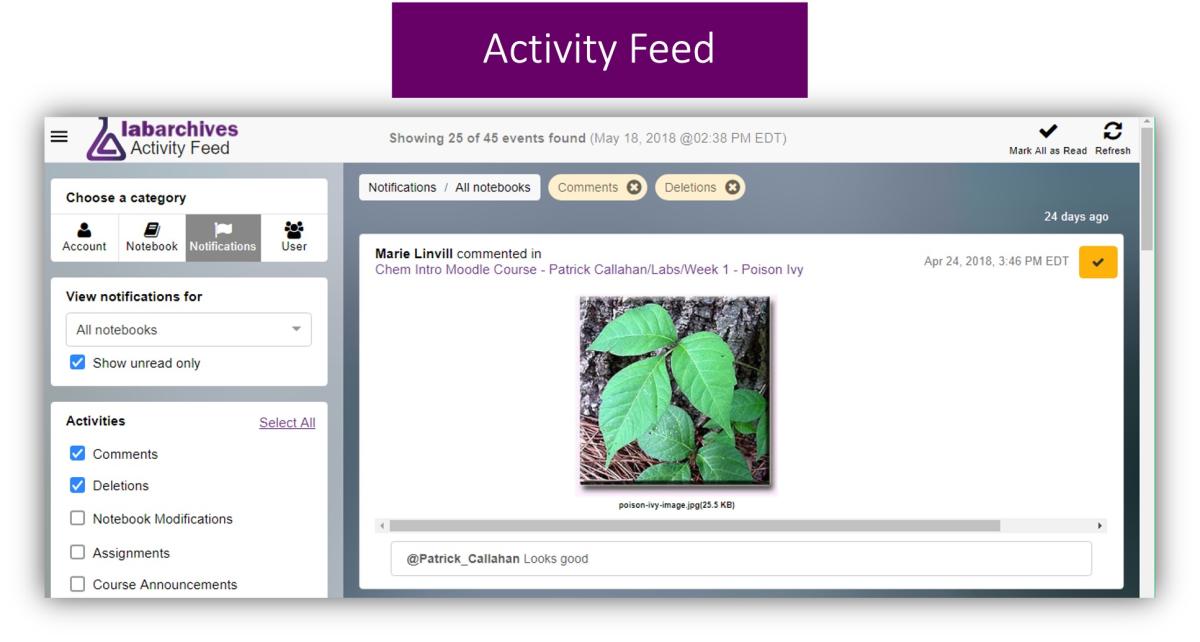News You Can Use
Electronic Lab Notebook (ELN) Updates
BY THE NIH ELN IMPLEMENTATION TEAM
As mentioned in the May-June issue of the NIH Catalyst, because of mandates (M-19-21 /M-23-7) that required the federal government to convert to electronic record keeping by June 2024, no new paper notebooks may be created going forward. NIH has adopted two different commercial electronic lab notebooks (ELNs): LabArchives, a general purpose ELN, and Signals, a chemistry-specific ELN. Both are available at no cost to NIH users.

CREDIT: NCI
Screenshot of an activity feed of a LabArchives ELN.
Although 100% of NIH principal investigators have formally declared their ELN system of record, many groups have only recently completed training and onboarding. Legacy paper notebooks needed for scientific reference may continue to be managed in accordance with applicable records management requirements and do not need to be digitized. The following are a few more tips and some reminders as investigators embark on their new ELN journey.
The NIH policy on ELNs (OIR Sourcebook) states that a NIH lab notebook is a federal record that documents the complete research record in sufficient detail so the research can be reproduced by others (for example, why specific experiments were initiated, how they were performed, which biospecimens were used, what data and observations were produced, where the data are stored, or how the data were analyzed and interpreted).
Principal investigators and facility heads are considered “data owners” and are responsible for the overall management of content and access to data in ELNs. Data owners should maintain ownership of all notebooks used by their group members but may delegate most management functions to their account administrator or group members.
Use of other digital systems to store and analyze data does not normally replace the need for an ELN to serve as the central documentation hub. Exceptions to the need for an ELN include research that requires use of specialized documentation systems, such as clinical trials research, which are sufficiently comprehensive to meet the reproducibility standard. However, secondary reuse of clinical samples and data may require an ELN.
The ELN reproducibility standard is the same as any research documentation: Can a scientifically literate person with no prior knowledge of the project navigate the rationale, methods, experimental samples, results, analysis, and basis for the major conclusions entirely from the documentation provided in the ELN?
NIH ELN requirements have been designed to address the following.
- User-facing capabilities
- System security
- Records management
- Access and retention control of the ELN
- Federal records designation
- Investigator’s index record of retrievable data sources
Guidelines for ELN data storage
Sensitive administrative information such as CVs, grant and contract information, banking information, financial disclosures, performance ratings, disciplinary actions, and grievances not needed for research should not be stored in an ELN. Intellectual property related to invention reports, patents, and preclinical studies should be stored in the ELN. Investigators are advised to use witnessing with validated signatures and page-locking capabilities as needed for these applications.
Conditionally sensitive personally identifiable information, or PII, such as medical record numbers or image accession numbers may be used in the ELN when necessary to support clinical research. Investigators are encouraged to limit their use of conditionally sensitive PII to only the data elements required for their specific applications (for example, use age instead of birthdate when possible).
Clinical care and clinical trial data, genomic datasets, and large imaging datasets should be stored in appropriate platforms and systems designated by each IC. Use URLs or image thumbnails in the ELN to reference and link to the master data source(s). Smaller datasets such as those produced by laboratory instrumentation (for example, plate readers or flow cytometers) can be ingested into the ELN by uploading or via the application programming interface. If the lab or branch or investigator’s policy is to retain master copies on a group drive, users are advised to note the URL of the master copy in the ELN and regard the ELN copy as an operational copy.
Investigators wishing to make changes to their ELN declaration or request accounts, or need training or other types of support assistance with ELNs should submit an ELN support ticket. Answers to many frequently asked questions about the use of ELNs at NIH can be found in the FAQ section of the NIH policy on ELNs.
The NIH ELN Implementation Team includes Janelle Cortner (NCI), Anna Amar (OD), and Ute Reichling (NCI).
Keeping a Lab Notebook: Basic Principles and Best Practices Webinar hosted by NIH OITE on October 21, 2023
This page was last updated on Tuesday, November 5, 2024
